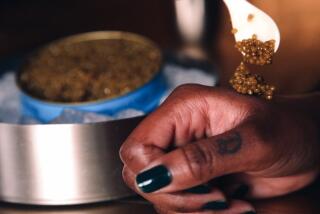Snail Caviar Slowly Catching On : Eggs From Garden-Variety Mollusks Fetch $40 an Ounce
- Share via
The average American snail, on a glide path toward someone’s petunias, seems to have few occupational hazards to worry about, other than avoiding the irate gardener. Not so its cousins in France, where for centuries gourmands have gathered the creatures as delicacies to be grilled with garlic butter or fricasseed in sauces.
Now gastronomes have designs on the snail for yet another reason: they covet the creatures’ eggs. For the last couple of years, fancy food emporiums like Fauchon in Paris and Fortnum and Mason in London have carried a kind of caviar made from snail eggs and the product has showed up on the menus of a few European luxury restaurants.
Americans with sufficient money and curiosity are now getting their chance, for snail caviar under the brand name Brut d’Escargot made its official U.S. debut this summer at a fancy food show in New York City.
Snail caviar seems destined to remain a rarity. Though no one in this country connected with its importation seems sure of how much is made, the amount can probably be measured in hundreds of pounds. Most snail caviar comes from Alain Chatillon, who has promoted the product almost single handedly from his company in southwestern France.
Priced at $40 an Ounce
Hardly any has appeared in U.S. shops and David Darwish, a Los Angeles importer who handles Chatillon’s Brut d’Escargot, estimated the retail price at around $40 an ounce, about the same as beluga caviar. Following a tasting held recently at La Maison du Caviar in Beverly Hills, Darwish sold some of the small glass jars of snail eggs to several high-priced restaurants in Southern California.
Availability aside, there’s the matter of the taste. Snail caviar doesn’t stand on its own, said Dominique Bamberger, vice president of the Beverly Hills restaurant where the introductory preview was held. “If you take a little on a spoon and you taste it, just like that,” he said, “it’s a little too . . . too . . . too surprising.”
The surprise comes from the pronounced licorice-like flavor of anise, added to the eggs during processing at Chatillon’s firm. Otherwise, Darwish said, they would taste like “absolutely nothing.”
In the natural state, they would be colorless as well. Processing turns the eggs, which range up to about an eighth of an inch in diameter, into the semblance of seed pearls, sometimes with a tan cast. Snail eggs seem best suited as a touch of conspicuous consumption in combination with other foods.
Lionel Denmiaud, chef at La Maison du Caviar, came up with appetizers of foie gras and scrambled quail eggs garnished with snail caviar. Another was a pastry shell filled with a snail mousse, again with the eggs as an added touch.
Different Approach
A different approach is being taken by another California chef, Martin Woesle, at Mille Fleurs, a highly regarded restaurant in Rancho Santa Fe, an upper-income community north of San Diego. He has been experimenting with eggs obtained from a snail ranch in nearby Riverside.
“I make a reduction of Champagne and saffron until it is very strong and then I cool it,” he said. “I put the eggs in for about half an hour.”
They emerge with a reddish gold tint, to be used for decoration. Asked why he bothered, he said, “Well, it’s new--and it looks very nice.”
Compared to the sturgeon, the snail is a miserly producer of caviar. Where a fish caught in the Caspian Sea might carry as much as 40 pounds of the precious eggs, a snail will lay about four grams worth once a year. That means that it takes upwards of 15 snails to produce one 50-gram jar of Brut d’Escargot, about two tablespoons’ worth. But every snail contributes its share. The creatures are hermaphrodites and perform both male and female roles at mating time.
The snails lay their clutches in potting soil provided for the purpose and then it’s up to workers to separate out the eggs, grade them and send them on for processing.
Some of the farmers who supply Chatillon’s firm are said to run herds of 40,000 snails feeding them on vegetables and sprinkling them with water from time to time to make them think it’s raining. It sounds like an idyllic existence, if you’re a snail, but only the petit-gris variety need apply. This is the species most prized for eating and its eggs are described as having “a remarkable finesse and lightness” and “the milky aspect of cultured pearls,” or so said a Brut d’Escargot handout.
Cured in Flavored Brine
The details of Chatillon’s process are proprietary but in essence the eggs are cured for 30 days to 45 days in a flavored brine. After that they are pasteurized so that they can withstand shipping and refrigerator storage of up to four months. Despite having no background in the food business--press reports have quoted him as saying that his previous occupations have included telling fortunes with tarot cards and selling real estate in Spain--Chatillon has promoted snail caviar into one of the most talked about, if not tasted, food novelties of the day.
Darwish hints that Brut d’Escargot may get competition. He said that there were a number of suppliers in France experimenting with snail caviar on a home-made basis. “I think that’s probably the way it originally got started,” he said.
More to Read
Eat your way across L.A.
Get our weekly Tasting Notes newsletter for reviews, news and more.
You may occasionally receive promotional content from the Los Angeles Times.









